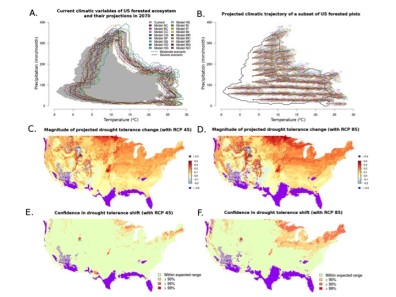New research quantifies US forest vulnerability to drought stress expected with climate change
john_harrisonAlthough it is widely recognized that climate change will require a major spatial reorganization of forests, our ability to predict exactly how and where forest characteristics and distributions will change has been limited. Current efforts to predict future distribution of forested ecosystems as a function of climate include species distribution models (for fine scale predictions) and potential vegetation climate envelope models (for coarse-grained, large scale predictions). In this paper, titled U.S. Forest Response to Projected Climate-Related Stress: a Tolerance Perspective (Lienard, Harrison, and Strigul In Press at Global Change Biology), an intermediate approach is developed and applied. In this approach, we use stand-level tolerances of environmental stressors to understand forest distributions and vulnerabilities to anticipated climate change. In contrast to other existing models, this approach can be applied at a continental scale while maintaining a direct link to ecologically relevant, climate-related stressors. We demonstrate that shade, d rought, and waterlogging tolerances of forest stands are strongly correlated with climate and edaphic conditions in the conterminous US. This discovery allows the development of a Tolerance Distribution Model (TDM), a novel quantitative tool to assess landscape level impacts of climate change. We then focus on evaluating the implications of the drought TDM. Using an ensemble of 17 climate change models to drive this TDM, we estimate that 18% of US ecosystems are vulnerable to drought-related stress over the coming century. Vulnerable areas include mostly the Midwest US and Northeast US, as well as high elevation areas of the Rocky Mountains. We also infer stress incurred by shifting climate should create an opening for the establishment of forest types not currently seen in the conterminous US.
rought, and waterlogging tolerances of forest stands are strongly correlated with climate and edaphic conditions in the conterminous US. This discovery allows the development of a Tolerance Distribution Model (TDM), a novel quantitative tool to assess landscape level impacts of climate change. We then focus on evaluating the implications of the drought TDM. Using an ensemble of 17 climate change models to drive this TDM, we estimate that 18% of US ecosystems are vulnerable to drought-related stress over the coming century. Vulnerable areas include mostly the Midwest US and Northeast US, as well as high elevation areas of the Rocky Mountains. We also infer stress incurred by shifting climate should create an opening for the establishment of forest types not currently seen in the conterminous US.